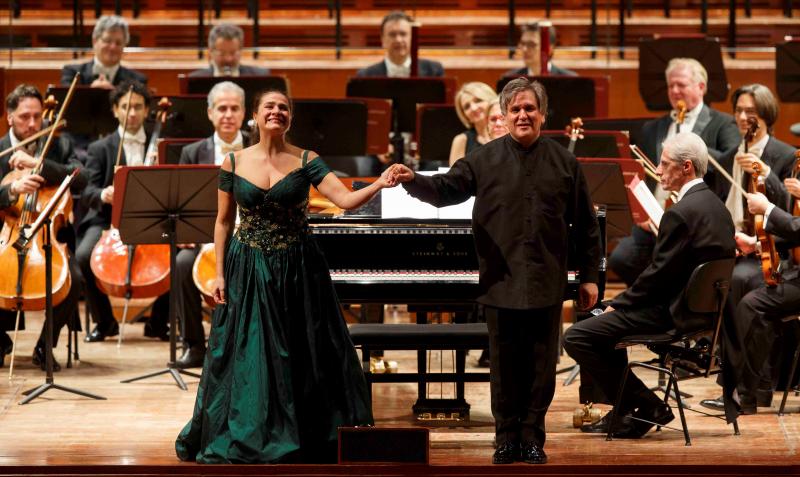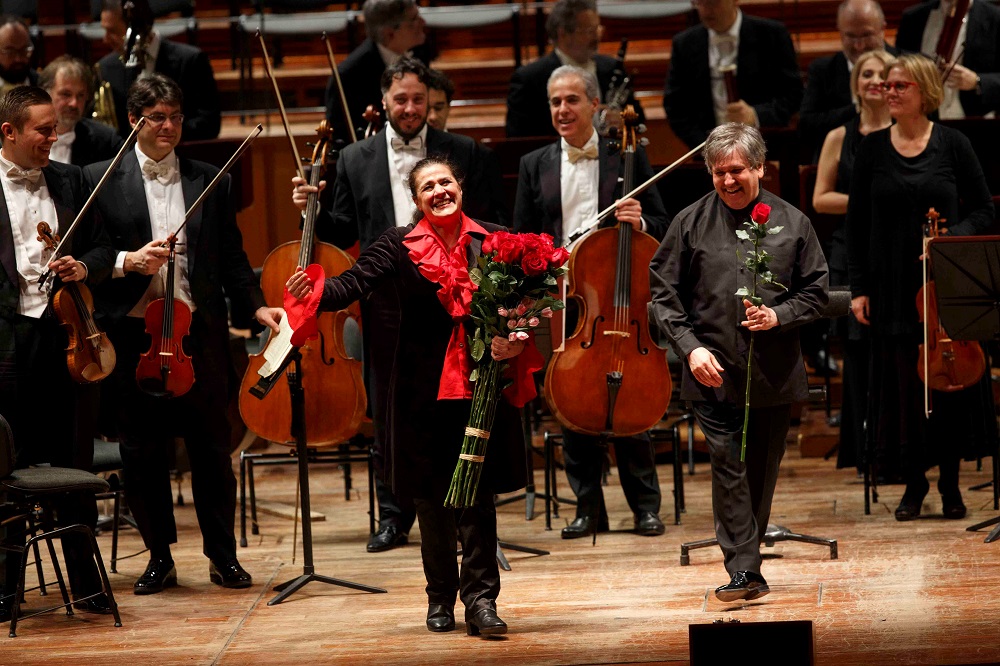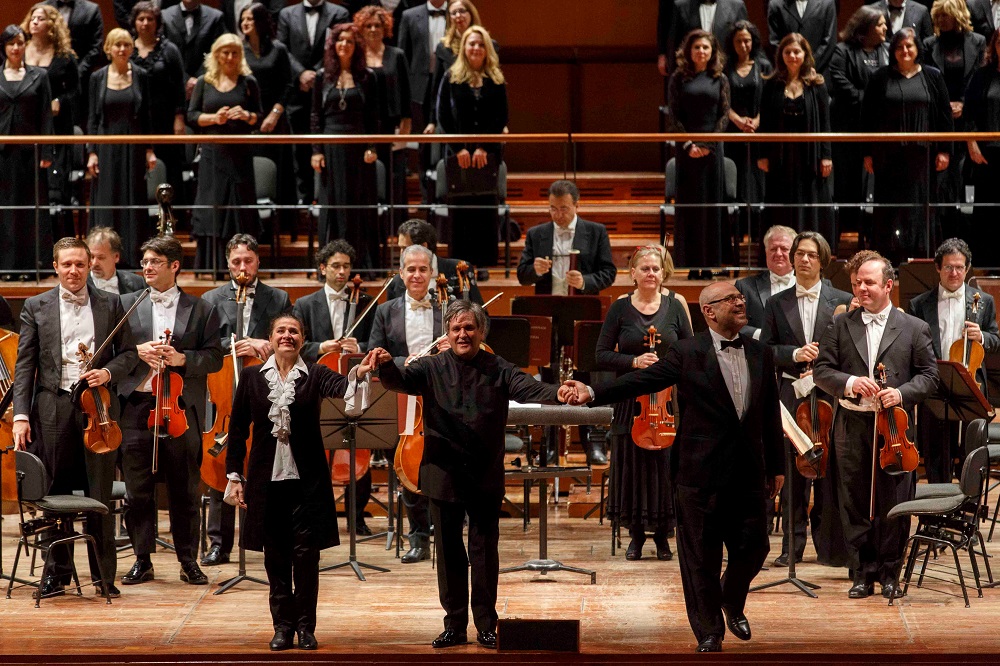theartsdesk in Rome: Bartoli and Pappano on home turf | reviews, news & interviews
theartsdesk in Rome: Bartoli and Pappano on home turf
theartsdesk in Rome: Bartoli and Pappano on home turf
Bach and Mozart in distinguished profile

Wherever you are in the world, opportunities to see Cecilia Bartoli perform are hard to come by. A one-off chance to see her sing Mozart in Rome was not to be missed. This was a rare homecoming for Bartoli. Born in Rome, she studied at the city’s Conservatorio di Santa Cecilia where many members of the orchestra teach.
These days, with due allowance made for Bellini’s Norma, she uses her fame to work in the byways of the Baroque and Classical eras with exquisitely curated studio albums, and occasional appearances in venues carefully chosen to flatter what was never a capacious, Marilyn Horne or Christa Ludwig size of mezzo-soprano.
Agreeing to appear, then, in the orchestra’s cavernous home at the Renzo Piano-designed Parco della Musica was – to put a charitable spin on it – a generous gesture. From halfway back in the stalls, one heard 50 percent Bartoli, 50 percent echo. Still, she knew her audience. And, boy, did they know her. Cries of "Evviva" rang out as soon as she appeared in the first of her four costumes for the evening. In Exsultate, jubilate, her vocal divisions flew in all directions like petals from a bouquet of brandished roses (more of them later). She still has a machine-gun lower-register that spits notes like tank shells. And she hugely over-compensated for the cavernous acoustic with a vocal personality that reached out from the stage and grabbed every audience-member by the lapels, and by some more intimate parts too. Her top C in the final "Alleluja" was nudged out mezzo-forte with the wisdom of experience.

It takes a force of nature to upstage the well-loved Antonio Pappano, no less at home here, and he ruefully acknowledged, "We have our Saint Cecilia here." But the evening was billed as a birthday party for Mozart, born 261 years ago, and the celebrations were not all about Bartoli. The first half concentrated on the sacred side of the composer’s protean musical personality, and the well-drilled Chorus of Santa Cecilia turned in performances of Misericordias Domini and Ave verum that more than made up in Verdian passion for what they may have lacked, to dessicated English ears, in Classical refinement.
Even so, the Santa Cecilia orchestra only sounded comfortable in a period skin – clipped phrasing, minimal vibrato, very sleek – once expanded to something near full strength in the second half for the "Paris" Symphony and the final fugue of the ‘’Jupiter". When I first saw this orchestra 20 years ago, in the gilt acoustic dustbin of their old home on the Via della Conciliazione, they could never have played this music with such verve and polish.
Bartoli returned in a flurry of silk blouses for two of Mozart’s loveliest concert arias, though Pappano’s obbligato piano for Ch’io mi scordi di te was almost wholly lost to the roof of the hall. She was in her operatic element for "Parto, parto" from La clemenza di Tito, where there is hardly a mezzo to touch her: certainly not her admirers, who shambled up with ever more outsize bouquets. The security guards had to prevent one elderly gentleman from clambering on stage with a jiffy bag which looked for all the world as though it held a 500-page handwritten proposal of marriage.

Rather perturbingly, hall and orchestra sounded more comfortably accommodated with each other the following afternoon, when I dropped into their recording session with the cellist Guy Johnston. He was in town to tape Respighi for the latest leg of a project (eventually to result in a disc on the King’s College Choir label) tracing the history of his cello, made almost 300 years ago in the Roman workshop of David Tecchler. A stone’s throw from the workshop, he then gave a Sunday-morning recital of the first three solo Bach Suites, at a church nestled in the crook of the Tiber.
The stone walls and handsome murals of the Oratorio del Gonfalone lent their own persuasive context to Johnston’s suggestion that the suites, considered together, trace the birth, death and resurrection of Christ. This was superbly direct Bach playing, tonally spare, unsentimental, with a sense of harmonic progress as plain and decisive as the curve of a Roman arch. By not mining every nugget of tone from the lower strings, he secured a lively speaking quality from the Tecchler: the Third Suite’s Courante gossiped away, before the weak beats of the Minuets were flicked off with a shrug.
The future of Arts Journalism
You can stop theartsdesk.com closing!
We urgently need financing to survive. Our fundraising drive has thus far raised £49,000 but we need to reach £100,000 or we will be forced to close. Please contribute here: https://gofund.me/c3f6033d
And if you can forward this information to anyone who might assist, we’d be grateful.

Subscribe to theartsdesk.com
Thank you for continuing to read our work on theartsdesk.com. For unlimited access to every article in its entirety, including our archive of more than 15,000 pieces, we're asking for £5 per month or £40 per year. We feel it's a very good deal, and hope you do too.
To take a subscription now simply click here.
And if you're looking for that extra gift for a friend or family member, why not treat them to a theartsdesk.com gift subscription?
more Classical music
 Kaploukhii, Greenwich Chamber Orchestra, Cutts, St James's Piccadilly review - promising young pianist
A robust and assertive Beethoven concerto suggests a player to follow
Kaploukhii, Greenwich Chamber Orchestra, Cutts, St James's Piccadilly review - promising young pianist
A robust and assertive Beethoven concerto suggests a player to follow
 Robin Holloway: Music's Odyssey review - lessons in composition
Broad and idiosyncratic survey of classical music is insightful but slightly indigestible
Robin Holloway: Music's Odyssey review - lessons in composition
Broad and idiosyncratic survey of classical music is insightful but slightly indigestible
 Classical CDs: Wolf-pelts, clowns and social realism
British ballet scores, 19th century cello works and contemporary piano etudes
Classical CDs: Wolf-pelts, clowns and social realism
British ballet scores, 19th century cello works and contemporary piano etudes
 Bizet in 150th anniversary year: rich and rare French offerings from Palazzetto Bru Zane
Specialists in French romantic music unveil a treasure trove both live and on disc
Bizet in 150th anniversary year: rich and rare French offerings from Palazzetto Bru Zane
Specialists in French romantic music unveil a treasure trove both live and on disc
 Scottish Chamber Orchestra, Ibragimova, Queen’s Hall, Edinburgh review - rarities, novelties and drumrolls
A pity the SCO didn't pick a better showcase for a shining guest artist
Scottish Chamber Orchestra, Ibragimova, Queen’s Hall, Edinburgh review - rarities, novelties and drumrolls
A pity the SCO didn't pick a better showcase for a shining guest artist
 Kilsby, Parkes, Sinfonia of London, Wilson, Barbican review - string things zing and sing in expert hands
British masterpieces for strings plus other-worldly tenor and horn - and a muscular rarity
Kilsby, Parkes, Sinfonia of London, Wilson, Barbican review - string things zing and sing in expert hands
British masterpieces for strings plus other-worldly tenor and horn - and a muscular rarity
 From Historical to Hip-Hop, Classically Black Music Festival, Kings Place review - a cluster of impressive stars for the future
From quasi-Mozartian elegance to the gritty humour of a kitchen inspection
From Historical to Hip-Hop, Classically Black Music Festival, Kings Place review - a cluster of impressive stars for the future
From quasi-Mozartian elegance to the gritty humour of a kitchen inspection
 Shibe, LSO, Adès, Barbican review - gaudy and glorious new music alongside serene Sibelius
Adès’s passion makes persuasive case for the music he loves, both new and old
Shibe, LSO, Adès, Barbican review - gaudy and glorious new music alongside serene Sibelius
Adès’s passion makes persuasive case for the music he loves, both new and old
 Anja Mittermüller, Richard Fu, Wigmore Hall review - a glorious hall debut
The Austrian mezzo shines - at the age of 22
Anja Mittermüller, Richard Fu, Wigmore Hall review - a glorious hall debut
The Austrian mezzo shines - at the age of 22
 First Person: clarinettist Oliver Pashley on the new horizons of The Hermes Experiment's latest album
Compositions by members of this unusual quartet feature for the first time
First Person: clarinettist Oliver Pashley on the new horizons of The Hermes Experiment's latest album
Compositions by members of this unusual quartet feature for the first time
 Gesualdo Passione, Les Arts Florissants, Amala Dior Company, Barbican review - inspired collaboration excavates the music's humanity
At times it was like watching an anarchic religious procession
Gesualdo Passione, Les Arts Florissants, Amala Dior Company, Barbican review - inspired collaboration excavates the music's humanity
At times it was like watching an anarchic religious procession

Add comment